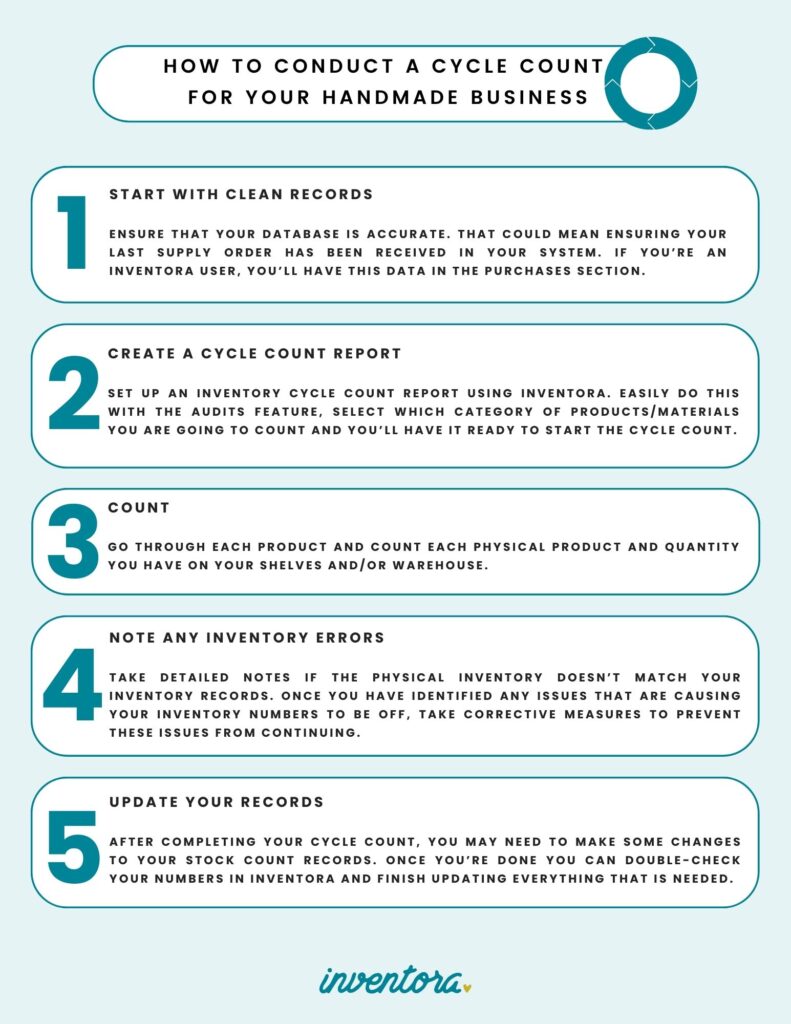
Inaccurate inventory counts are one of the key ways businesses lose revenue and sales. Thankfully, there is a defense system to keep your inventory from resulting in chaos. The solution is understanding how to apply inventory cycle counting to your business.
When counts are off, it affects your ability to fulfill orders and provide excellent customer service. Off counts can lead to issues like excess carrying costs on inventory you don’t need and aren’t likely to sell. This is why maintaining accurate inventory counts should be a large priority of every business and is one of the vital inventory management tips and tricks.
What is Cycle Counting?

The first step in understanding how to apply inventory cycle counting to your business, is to learn the very basics of what this handmade inventory management structure is all about. You must comprehend that cycle counting is the process of counting small sections of your inventory. Know this is done so you are able to cycle through your entire inventory on a consistent basis.
An inventory cycle count will result in small adjustments made to your inventory quantities regularly. This method involves performing a regular count and recording the adjustment of specific products.
In essence, an inventory cycle count is very similar to the normal physical inventory counts. The only difference is that cycle counting does so with a different approach. When you take a physical inventory count, you count 100% of your inventory at once. But with cycle counting, you can complete quantity control in small portions. Thus, allowing you to go over all of your stock a little at a time in a focused manner. This vastly lowers the risk of inaccuracies and costly inventory mistakes.
The Importance of Cycle Counting
The key benefit of conducting cycle counting is understanding what you physically have on hand, versus what your inventory management software says you should have. Human error can create discrepancies between your actual inventory and the one you track with your inventory software. Therefore, it’s necessary to run physical quantity checks every so often.
These discrepancies will compound over time and can eventually cost your business a significant amount of money. This particularly can happen for eCommerce businesses. The risk of discrepancies is higher for these types of businesses because if their inventory counts don’t sync up with their available products on online marketplaces, they may be unable to fulfill orders.
If you are a multi-channel seller without an integrated inventory management system, you know too well how easily you can get off track with inventory counts. Not having inventory management tips and tricks to rely on can make things even more difficult. When you are selling on multiple platforms with individual reporting systems, it can be a challenge to be on top of every detail.
Relying on a simple inventory system, like Inventora, is key to learning how to apply inventory cycle counting to your business. Applying cycle counting can help you have healthy and accurate stock levels of each one of your products and raw material inventory. As a benefit, this can increase your production line and speed up the process of fulfilling orders.
What Happens When You Don’t Do Cycle Counts?
Lack Of Awareness: This simply means that if you don’t prioritize inventory cycle counting you won’t know where your money is. Many handmade business owners and manufacturers aren’t fully aware of all the products on their shelves. This not only impacts your inventory records, but this means you probably are making business decisions based on guesswork rather than data.
Hidden Inventory: By conducting cycle counts you will know what products you’re sitting on and losing money from. It can bring to light products that tend to expire before you move them. Thus, allowing you to lower your reorder quantity. Cycle counting can identify products that may be hidden in the back of your shelves before doing more.
Stockouts Or Excess Inventory: Inventory cycle count data can show trends on which products you’re spending money on that aren’t moving. This is instead of the products that always seem to be low in stock. You can detect if some of your products haven’t moved much during the last few counts with this system. Cycle counting can help you decide to stop selling those products, or run a sale to make some space on your shelves for the products that really matter.
Cycle counts are a key component to optimizing your production and time management. By doing so, you will be less likely to make human made errors and be in a better spot to enhance your customer experience.
Benefits of Cycle Counting

Although we could mention several benefits to knowing how to apply inventory cycle counting to your business, there are three main perks that we want to discuss. Each of these positive contributions will not only allow you business to better organize it’s financial state, but it will also help with the streamlining portion of your business. The three main benefits of cycle counting are…
Quickly Identifying Operational Or Product Issues: If you do cycle counts as part of your routine it gives you a better chance of identifying the specific issue since it should have occurred more recently from your last count. That way when you have your end-of-year physical inventory count you don’t have as many surprises.
Accurate Inventory Counts Across Channels: This is key and essential for e-commerce and multi-channel sellers, this will also help you have better management if you’re using inventory software because you’ll have the numbers updated and you’ll have fewer differences.
Reliable Data: Regularly conducting inventory cycle counts allows you to have accurate sales data and inventory valuation. Your products are your biggest asset so keeping correct tracking of them will help you make smarter inventory decisions.
Methods of Cycle Counting
Similar to the benefits of cycle counting, there are three different methods that you can select from. Each method is based upon how you prefer to run your business. These methods are control group, random sample, and ABC cycle counting and can be a useful tool to add to your playbook for inventory management tips and tricks.
Control Group Cycle Counting
This process utilizes a control group then takes that data and expands it to larger sets of your handmade inventory management. It allows you to practice your cycle counting and refine it over time until it’s good enough to use on a large scale.
Random Sample Cycle Counting
Random sample cycle counting is a great option for companies who have many similar items. With this approach, you can select a random number of items to be counted during each cycle count. This will help businesses that have a large number of similar items. You will then randomly select a certain number of items to be counted.
ABC Cycle Counting
If your handmade business or manufacturing company is scaling and your inventory is increasing, the chances of your products going out of stock are much greater.
ABC cycle counting operates on the Pareto principle, which many people know as the “80/20 rule.” In this principle, the belief is that 80% of your results come from 20% of your products. By breaking products down into A, B, and C categories, you can better focus on the products driving most of your results.
Subcategories of ABC Cycle Counting

A: High-value/usage products (70%) and 10% of your physical inventory.
B: Moderate in value/usage products (20%) and 20% of your physical inventory.
C: Small value/usage products (10%) and 70% of your physical inventory.
This process helps you prioritize the products that have the highest value or usage compared to random sampling cycle counting.
Although all methods are great choices, you should take time to really consider which option is best suited for the type of business you run. Depending on how you’ve structured your business, how much staff you have, and the rate at which you like to get projects accomplished, will all factor into which method will work best for you. Selecting the appropriate method for your business will be key to the process of how to apply inventory cycle counting to your business.
How To Conduct A Cycle Count
Now that we have discussed the benefits of cycle counting, as well as the three core methods to cycle counting, let’s discuss the actual benefits. As business owners, we know our time is so valuable. This is why it’s crucial for us to do our research on big projects before we drive head first into the water. Understand that learning how to apply inventory cycle counting to your business, is not a hard task to complete. However, it will take a little bit of focused time to first get started. If you use Inventora, you are already one step ahead! But, here are the steps mapped out plainly.
Step 1: Start with Clean Records
Before you begin your cycle count, ensure that your database is accurate. That could mean ensuring your last product delivery has been received in your system. If you’re an Inventora user, you’ll have this data in the purchases section.
Step 2: Create a Cycle Count Report
Set up an inventory cycle count report using an inventory management system, like Inventora. Track which products you have accounted for and any discrepancies. Easily do this with the Inventora audits feature. Select which category of products and raw material inventory you are going to count and you’ll have it ready to start the cycle count.
Step 3: Count Your Inventory
Go through each product and count each physical product and quantity you have in your shelves and/or warehouse.
Step 4: Note Any Inventory Errors
Take detailed notes if your physical inventory doesn’t match your inventory records. Look into any differences to see if you can identify where this is coming from. Once you have identified any issues that are causing your inventory numbers to be off, take corrective measures to prevent these issues from continuing.
Step 5: Update Your Records
After completing your cycle count, you may need to make some changes to your stock count records. Once you’re done you can double-check your numbers in Inventora and finish updating everything that is needed.

Using an inventory management system, like Inventora can help you automate cycle counting. This will show you any discrepancies and will push out any inventory updates to all your sales channels at once. You can view or download previous audits and reports. Thus giving you better transparency on patterns where errors occur, and trends allowing you to make smarter business decisions.
Closing Thoughts
Our best advice in understanding how to apply inventory cycle counting to your business, is to have cycle counting as part of your regular routine operations. If you have an employee it is better to do this with him or her to have more accurate results.
Be sure to close out all shipping, receiving, and work-in-progress transactions first for the products you’re cycling counting and complete your inventory count before or after daily operations. This is to be done so you aren’t distracted by a busy day and your sales don’t change the data during the count.
Cycle counting will ensure you have accurate numbers, avoid spending your money in the wrong places, and increase your business revenue.
Get started cycle counting today with the help of Inventora! Streamline your business and automate the tasks you dread as a business owner. Say goodbye to manual, and hello to automation! All at the touch of your finger tips.
For more information about Inventora, sign up for our newsletter below. Receive exclusive offers, special announcements, and access to limited seated e-events. Join Inventora at no cost with our hobby plan, or get unlimited access to all of our features with our affordable business plan.


